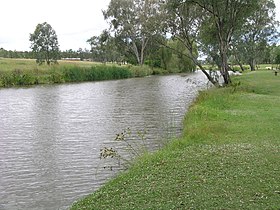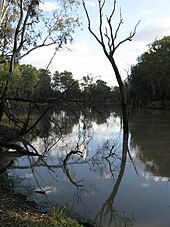Condamine River
| Condamine | |
|---|---|
 Condamine River,Warwick,2009 | |
Location of Condamine Rivermouthin Queensland | |
| Etymology | In honour of Thomas de la Condamine |
| Location | |
| Country | Australia |
| State | Queensland |
| Regions | Darling Downs,South West Queensland |
| Settlements | Killarney,Warwick |
| Physical characteristics | |
| Source | Mount Superbus |
| • location | The HeadnearMain Range National Park |
| • coordinates | 28°14′42″S152°28′21″E/ 28.24500°S 152.47250°E |
| • elevation | 772 m (2,533 ft) |
| Mouth | confluencewith the Dogwood Creek to form theBalonne River |
• location | betweenSuratandCondamine |
• coordinates | 27°03′20″S149°37′37″E/ 27.05556°S 149.62694°E |
• elevation | 256 m (840 ft) |
| Length | 657 km (408 mi) |
| Basin size | 13,292 km2(5,132 sq mi) |
| Basin features | |
| River system | Balonnecatchment, Murray-Darling basin |
| Tributaries | |
| • left | Sandy Creek (Condamine River), Wilkie Creek, Wambo Creek, Undulla Creek |
| • right | Emu Creek (Condamine River), Swan Creek (Condamine River), Glengallen Creek, Dalrymple Creek, Kings Creek (Condamine River), Hodgson Creek,Oakey Creek,Myall Creek,Jimbour Creek,Cooranga Creek, Charleys Creek |
| Reservoirsandweirs | Talgai Weir, Yarramalong Weir, Lemon Tree Weir, Loudoun Weir, Tipton Weir, Cecil Plains Weir |
| [1] | |
TheCondamine River,part of theBalonnecatchment that is part of theMurray-Darling Basin,drains the northern portion of theDarling Downs,an area of sub-coastal southernQueensland,Australia. The river is approximately 500 kilometres (310 mi) long and rises onMount Superbus,South East Queensland's highest peak, on the western slopes of theGreat Dividing Range,approximately 100 kilometres (62 mi) from the east coast of Queensland, and then flows north west across the Darling Downs, then west.[2]The Condamine River is a tributary of theDarling River.
Course and features
[edit]
The headwaters of the river rise on the slopes ofMount Superbus,part of theMain Range,before passing throughCambanoora Gorge.The river flows through the towns ofKillarney,Warwick,andChinchillaand the tributary Gowrie Creek drains the slopes aroundToowoomba.At the junction with Dogwood Creek, south ofYuleba,the Condamine turns to the south-west and becomes known as the Balonne River.[3]The Condamine descends 516 metres (1,693 ft) over its 657-kilometre (408 mi)course,[1]with acatchment areaof 13,292 square kilometres (5,132 sq mi).[4]The water basin contains more than 1,800 wetlands.[5]
TheBalonne Riveris joined byBungil CreekatSurat[2]followed by the Cogoon River (Muckadilla Creek) before a major junction with theMaranoa Riverat Lake Kajarabie aboveSt Georgefrom where it continues southwest toDirranbandi.Below Dirranbandi the Balonne forks into a series of anabranches with a western distributary being called theCulgoa Riverwhich, in turn, flows into theDarling River.The eastern branch of the Balonne River in turn branches again - into the Bokhara River on the right and the Narran River on the left (eastern) side. The Narran flows toNarran Lake,an endorheic lake betweenBrewarrina,WalgettandLightning Ridge.The Birrie splits from the Bokhara before these join with theBarwon Riverwest of Brewarrina which also flows into the Darling River.[citation needed]
Water storage
[edit]
Water from the Condamine River is used for town water supply and forirrigation.Leslie Damon Sandy Creek, a tributary of the Condamine, is the main water reservoir forWarwick.Talgai Weir is a small weir that can hold 640 megalitres (140×106imp gal; 170×106US gal) nearClifton.[3]Other water storage facilities on the Condamine River include the Yarramalong Weir, Lemon Tree Weir, Loudoun Weir, Tipton Weir and the Cecil Plains Weir. The Condamine River is reduced to a series of drying ponds duringdroughts in Australia.[citation needed]
Chinchilla Weir
[edit]The Chinchilla Weir was built in 1973 and is located on the Condamine River, eight kilometres south of the town of Chinchilla. The weir has the dual purpose of providing supply of irrigation water along the alluvial flats of the Condamine River and of augmenting the water supply to the town of Chinchilla. Chinchilla Weir is a concrete faced earthfill structure and is known for the unique curved design of its wall. The weir is the only storage for the Chinchilla Weir Water Supply Scheme.[citation needed]
At the official opening of the Weir in 1974, approximately 5000 people were counted through the gates. Chinchilla Weir remains a freshwater playground for locals and visitors with waterskiing, canoeing, swimming and fishing being popular activities.[6]
History
[edit]Parts of the water catchment were settled by theBundjalung people.The Condamine River was named byAllan Cunninghamin 1827 for Thomas de la Condamine, a formeraide-de-campto GovernorRalph Darlingwho became the colony's first Collector of Internal Revenue.Patrick Lesliewas the first white settler in the area. He establishedCanning Downsin 1840, near Warwick.[citation needed]
MajorThomas Mitchellcrossed the Balonne River on St George's Day, 23 April 1846. The next year 1847Ludwig Leichhardtwent to examine the course of the Condamine River.[citation needed]


In 1985, it was proposed by the Water Research Foundation of Australia to transfer water from theClarence Riverto the Condamine water basin.[7]The Condamine River and its catchment area were involved in the2010–11 Queensland floods.During the floods the river reached a record peak atCondamineof 15.25 metres (50.0 ft) and another peak of 14.67 metres (48.1 ft).[8]
Coal Seam Gas industry
[edit]The Coal Seam Gas industry (often referred to asCoal Bed Methane) started exploring forunconventional gasin the Chinchilla region, through which the Condamine River flows, around 2000 when Bob Bryan formed The Queensland Gas Company (QGC).[9]Initially supplying gas into the domestic market, the industry grew quickly with the advent of the CSG/LNG industry and building of export facilities inGladstone.[citation needed]
The gas is found in the coal seams and is adsorbed to the coal by water pressure. To extract gas from coal seams it is necessary to remove the water from the coal seams to allow the gas to flow.[10]The de-watering of the Walloon Coal Measures has been raised as a concern by landholders, as stock water bores drilled into the coal seams can be affected by reduced water flows or gas.[11]Under Queensland law, gas companies are required to "make good"if there is an impairment on a landholder's bore.[12]
The Walloon Coal Measures are hydraulically connected to the aquifers of the Great Artesian Basin (within the Surat Basin) and in some locations immediately underlies the Condamine Alluvium.[13]
Methane gas seeps
[edit]In 2012 methane gas was observed escaping from the river.[14]The gas that is seeping is derived either from the underlying Walloon Coal Measures and/or the Springbok Sandstone. The Queensland Government undertook an investigation into the gas seeps and the technical study concluded that the bubbling was unlikely to be caused by coal seam gas (CSG) activities in the region, but that further studies were required. In relation to the presence of methane in the river, the report concluded that “…there is no safety risk or evidence of environmental harm occurring in the immediate area from the Condamine River gas seeps. "[15]
In April 2016 the Condamine River seeps were brought to the forefront of media attention by New South WalesGreensMPJeremy Buckingham,when he allegedly set alight themethane gasbubbling from the riverbed. He claimed that "hydraulic fracturing"was the likely cause for the problem, but to date there is no direct link.[16][17]
In 2017 CSIRO researchers with expertise in hydrogeology, geology, ecology and biogeochemistry assessed the Condamine River to determine what is currently known about the methane seeps in the River including natural and human causes, and the potential human and environmental health and safety impacts of methane escaping from underground.[18]They concluded that there could be a number of reasons for the methane releases, but conceded that "depressurisation of the Walloon Coal Measures during gas production could generate horizontal migration of methane gas. However, this flux of methane is likely to be small because of the shallow dip of the coal beds and the distance to gas production fields." Other reasons for variation in bubbles includes changes in water flow, or flooding changing groundwater patterns. Hydraulic fracturing is not considered to be the cause as there has been no hydraulic fracturing in those fields.[citation needed]
Natural gas seeps are not altogether uncommon in Queensland, but there are no recorded instances of bubbles occurring in a river. The Queensland Gasfields Commission (a government agency) identified 17 soil gas surveys undertaken during the 1980s and 1990s, from locations around the state that record naturally occurring methane releases. The nearest one to the bubbling in the Condamine river was 16 km distant and not linked to the river. These measured low levels of mixed gas ranging from less than 10 parts per million (ppm) to 240ppm occurring in the subsoil at depths of up to one metre.[19]
In 2017, the gas company that holds the tenure over this area of the river reported a 90% reduction in the level of the seep compared to the peak rate recorded in early-2016. This was done by intercepting and producing the gas before it reached the river, effectively taking it out of the system.[20]
See also
[edit]References
[edit]- ^ab"Map of Condamine River, QLD".Bonzle Digital Atlas of Australia.Archivedfrom the original on 18 October 2022.Retrieved10 February2013.
- ^abShaw, John H.,Collins Australian Encyclopedia,Collins, Sydney, 1984,ISBN0-00-217315-8
- ^abHarrison, Rod; Ernie James; Chris Sully; Bill Classon; Joy Eckermann (2008).Queensland Dams.Bayswater, Victoria:Australian Fishing Network. p. 154.ISBN978-1-86513-134-4.
- ^"State of the Rivers report: Condamine River".Department of Environment and Resource Management. 28 September 2009. Archived fromthe originalon 6 January 2010.Retrieved1 June2012.
- ^"Condamine River drainage sub-basin".WetlandInfo.Department of Environment and Heritage Protection.Archivedfrom the original on 24 April 2016.Retrieved25 April2016.
- ^"Western Downs Council - weirs, dams and lagoons".Western Downs Council.Archived fromthe originalon 10 May 2018.Retrieved10 May2018.
- ^Ghassemi, Fereidoun; Ian White (2007).Inter-Basin Water Transfer: Case Studies from Australia, United States, Canada, China and India.Cambridge University Press. p. 120.ISBN978-1139463041.Archivedfrom the original on 7 March 2016.Retrieved25 April2016.
- ^"Flood Warning System for the Condamine River to Cotswold".Bureau of Meteorology.Archivedfrom the original on 29 February 2012.Retrieved6 March2012.
- ^"Bob Byran AM".Queensland Business Leaders Hall of Fame.State Library of Queensland.Archivedfrom the original on 14 March 2018.Retrieved25 April2016.
- ^"CSIRO".What is Unconventional Gas.CSIRO.Archivedfrom the original on 7 July 2016.
- ^"Bore blowout sparks gas concerns".Beef Central.Nascon Media. 24 November 2014.Archivedfrom the original on 31 May 2016.Retrieved25 April2016.
- ^"How to Make Good".Gasfields Commission.Archivedfrom the original on 17 May 2018.Retrieved20 April2018.
- ^"Study to assess water connectivity in the Condamine".Connected Waters Initiative.University of NSW. 18 January 2014.Archivedfrom the original on 23 March 2016.Retrieved25 April2016.
- ^Mark Willacy (15 February 2016)."Condamine River's mysterious bubbling 'intensifying'".ABC News.Australian Broadcasting Corporation.Archivedfrom the original on 5 April 2016.Retrieved10 April2016.
- ^State of Queensland, Department of Natural Resources and Mines (2012)."Summary Technical Report - Part 1 Condamine River Gas Seep Investigation"(PDF).Condamine River Gas Seep Investigation.Archived fromthe original(PDF)on 20 April 2017.Retrieved7 July2016.
- ^Coultan, Mark (22 April 2016)."Greens MP sets river on fire in anti-coal seam gas protest".The Australian.News Corp Australia.Retrieved23 April2016.
- ^Williams, Patrick (23 April 2016)."Queensland river bubbling with methane gas set alight by Greens MP".ABC News.Australian Broadcasting Corporation.Archivedfrom the original on 23 April 2016.Retrieved23 April2016.
- ^"CSIRO GISERA Condamine River Fact Sheet".CSIRO GISERA.1 May 2018.Archivedfrom the original on 8 May 2018.
- ^"Historical evidence of landscape gas seeps in Qld coal basins"(PDF).Queensland Gasfields Commission. Archived fromthe original(PDF)on 16 August 2016.
- ^"APLNG - Condamine River seeps show significant decline"(PDF).Archived(PDF)from the original on 4 April 2018.
External links
[edit]![]() Media related toCondamine Riverat Wikimedia Commons
Media related toCondamine Riverat Wikimedia Commons

